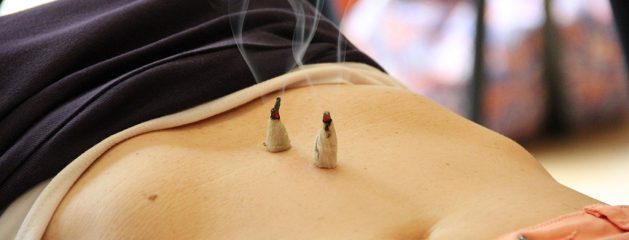Tibetan moxibustion practice is a fire healing therapy, which developed thousands of years ago. This method of healing is very appreciated in Tibet. It is effective and its material, the different types of Artemisia species that widely grow in Tibet used as moxa wool, is not expensive in high altitude land (now available in Chinese medicine and acupuncture shops). The technique principle is to warm or give heat on the natural body sang (gsang) points shown by the disease. The body is like a bamboo basket full of natural energy passages and connections between the external body and the internal organs. Psychic and body functions open and close these natural points. In other words, the body respires automatically. By the disease and under certain conditions, the points unusually open and the body’s positive energy is lost, weakening the person or blocking the energy and producing pain. To restore the health, moxibustion removes the negative energy, closes the points, controls the wind disorders, and helps the positive energy circulation in the passages, which is the life force and vital function of the person.
Tibetan physicians also discovered nineteen other tsug (heating therapies), which are also warming and heating therapies. They use various other materials such as tiger eye or gzi stone, golden needle therapy for the neurological disorders, copper heating for the blood vessels, etc.
There are four different moxa application methods
• Cooking moxa: Used one after the other for continuous heat
• Burning moxa: Direct, cone moxa for general disorders.
• Heating moxa: Light direct and indirect moxibustion on the skin points
• Warming moxa: Light moxa for children
Indications
Generally, moxa therapy is used for the following disorders:
Indigestion, low metabolism, low temperature, melancholy, pain caused by stress and tension, insomnia, anxiety, fear, panic attacks, stomach distension, vertigo, hiatus hernia, benign tumors, cold bile disease, joint pains, arthritis, orthopedic complaints, joint inflammation, superficial fever (empty fever), post-menopause syndrome and nerve inflammation (sciatic nerve, neurological disorders, etc.). In short, moxa treatment is effective for diseases that manifest from Phlegm and Wind humoral disorders.
The basic points are in three sections:
• 20 Back vertebrae points (BV)
• 9 Frontal points (FC, FA) and
• 41 Zubtsug points of body extremities.
The shortest moxibustion points were given on a chart, illustrated by Prof Pasang Yonten Arya with a short code name made for the students.
In this seminar, Prof Pasang Yonten Arya teaches the principles of Tibetan moxibustion, the preparation of the moxas cones, as well as how to use them for therapy.
………………………………………………………

